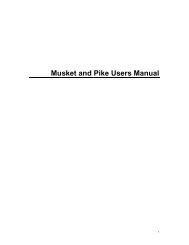Designer's note - Scenario Design Center
Designer's note - Scenario Design Center
Designer's note - Scenario Design Center
You also want an ePaper? Increase the reach of your titles
YUMPU automatically turns print PDFs into web optimized ePapers that Google loves.
Originally, the NATO OOB would be left on the battalion level exactly like the Warsaw Pact<br />
forces. However, we discussed the composition of the OOB for some time and finally<br />
decided it would be better to be given more freedom of action to the NATO and to break<br />
the battalions down to companies. Also this level mirrors NATO’s doctrine of flexible<br />
defence.<br />
As you can see, the US V and VII and German III and II Corps are the dominate NATO<br />
forces defending the "Fulda Gap". The two corps in the Fulda sector had five divisions<br />
plus the 11th Armoured Cavalry regiment and the Canadian 4th Mechanized Brigade.<br />
Approximately 18.000 men and 4400 vehicles were ready for the defence.<br />
The Warsaw Pact fielded three armies: the Soviet 1st Guard tanks and 8th Guard Army<br />
and the East German 3rd Army. These armies accounted for altogether 12 divisions plus<br />
an airmobile division or approximately 66,550 infantry and 5000 vehicles. In addition, a<br />
large number of artillery pieces and attack helicopters were available to both sides.<br />
The Warsaw Pact enjoyed a 3:1 superiority in men and a similar superiority in vehicles.<br />
The numbers like this are no surprise, above all the number of vehicles. When speaking<br />
of "vehicles", I mean tanks and armoured personnel carriers. Before I researched the<br />
equipment of the two sides, I always thought the Warsaw Pact to be vastly numerically<br />
superior in all weapon types. Surprisingly, I determined quickly that matters had evened<br />
out over the years and that NATO had more or less erased the tank deficit of the 60’s and<br />
70’s. This resulted from a restructuring of the land forces of an "infantry army "to a<br />
"mechanized army ".<br />
The NATO members always developed their weapon systems independent of each other,<br />
although striving for a measure of compatibility. For example, the American M1A1<br />
Abrams tank and the German Leopard II use the same main gun and can consequently<br />
fire the same ammunition. At this point, I want to mention that in Fulda Gap '85 the first M1<br />
Abrams variant with the 105mm cannon is used. Therefore, the M1 compares<br />
unfavourably with the Leopard II and its 125mm cannon. NATO developed the same<br />
calibre ammunition for different infantry and artillery weapons, thus enhancing logistic<br />
capability.<br />
The Soviet military power was one of the most highly sophisticated and modern armies of<br />
the world (at least on the paper). The backbone of the Soviet tank armed forces and other<br />
Warsaw Pact countries since the early 70’s was the T-72 tank of which approximately<br />
18.000 were built for Pact requirements as well as for export. Beginning in the 80’s, the<br />
Soviet government introduced the T-80 tank that would replace little by little, the T-72<br />
which would take on the back-up role of the T-64. A replacement spiral began, which has<br />
only stopped recently. Most Warsaw treaty states didn’t get any T-80s since the Soviet’s<br />
own requirements had priority. They still had to be content with the T-72 and its<br />
modernized variations.<br />
The Soviet Army came after China as the biggest in the world. With masses of reservists,<br />
it was the spectre of NATO. However impressive it seemed on paper, it had critical<br />
quality problems. The soldiers were badly trained, some of them had shot only a few<br />
times in their entire military career and had, moreover, very low morale.<br />
IIIa. Helicopters ( by Glenn Saunders )<br />
Page 10




